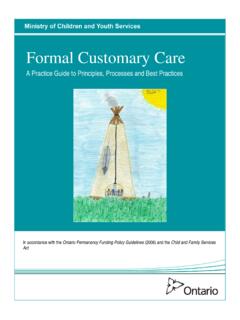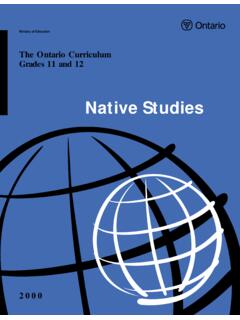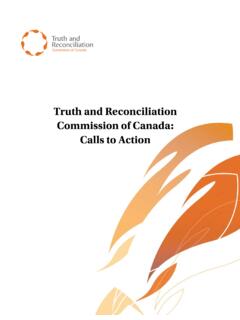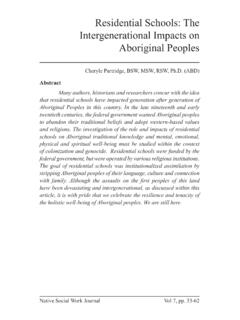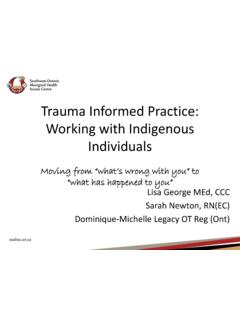Transcription of A Profile of Aboriginal Peoples in Ontario
1 A Profile OF Aboriginal Peoples IN Ontario This mural appears on a wall of the community centre at the Chippewas of Nawash Unceded First Nation. It was designed and painted by the children who attended the Nawash summer day camp in 2001. Christine Friday-Keeshig organized the mural, and Raphael Lito Iglesias was the artist who set it up based on the kids sketches. The quote included on the mural is from Nawash Elder Rose Nadjiwon, whose story, How the Birch Bark Got its Stripes is depicted. Noelle Spotton Opinions expressed are those of the author and do not necessarily reflect those of the Ipperwash Inquiry or the Commissioner.
2 List of Figures Figure 1: Demographic Snapshot of Aboriginal Peoples in Ontario Figure 2: Map of First Nations Communities Figure 3: Percentage Change of Aboriginal and Non- Aboriginal Populations, 1996 to 2001 Figure 4: Percentage of Ontario Population Figure 5: Access Map Figure 6: Age Figure 7: Family Status Figure 8: Education Figure 9: Employment and Unemployment Rate 2 INTRODUCTION The purpose of this background paper is to provide the reader with a general demographic Profile of Aboriginal Peoples in It is an overview of some key population, cultural, social, and economic characteristics of Aboriginal Peoples , based largely on data from the 2001 Canada Census.
3 Where appropriate and available, comparisons are made with the non- Aboriginal population of Ontario . This paper does not purport to be a definitive demographic Profile of the Aboriginal Peoples in Ontario . Rather, it acts as a very basic demographic primer. Demographic information is important for policy and planning purposes. Part of the Ipperwash Inquiry s mandate was to make recommendations that will help to avoid violence in circumstances similar to Ipperwash. In this regard, the Inquiry report and recommendations will act as a planning tool for the federal, provincial, municipal, and First Nations governments. As well, the policy part of the Inquiry will include references to Aboriginal youth and demographics, where Aboriginal Peoples live in Ontario , and the evolving social conditions and experiences of Aboriginal Peoples in Ontario .
4 This demographic Profile will assist the reader in understanding these references. As Figure 1 indicates, Aboriginal Peoples represent a small proportion of the total Ontario population. However, there are more Aboriginal people in Ontario than in any other province in Canada, and the City of Toronto has one of the largest, if not the largest, Aboriginal population in the country. Generally, Aboriginal Peoples are younger, more mobile, experience more single-parent families, are less well educated, experience more unemployment, earn less, and are incarcerated in greater proportions than non- Aboriginal Peoples . In Ontario , a large majority of Aboriginal Peoples do not live on reserves (or First Nation communities, as reserves are often called).
5 This paper does not analyze trends. However, as the Community Well-Being Index (discussed near the end of this paper) indicates, it often takes a long time for fundamental change to occur. The Index shows that the well-being of Aboriginal Peoples in Ontario improved, although not by much, between 1991 and 2001. 1 The Ipperwash Inquiry was appointed by the Province of Ontario . Therefore, this paper describes the Aboriginal Peoples who live within the borders of Ontario . 3 Figure 1: Demographic Snapshot of Aboriginal Peoples in Ontario Aboriginal Peoples Non- Aboriginal Peoples Comparison Total population 188,314 11,097.
6 235 Aboriginal population about of population of Ontario Percentage under 19 years 26% 48% more Aboriginal people under 19 years Percentage over 65 years 13% 65% fewer Aboriginal people over 65 years Percentage living off reserve 78% NA living on reserve Percentage who were living at same address for at least one year 8% fewer Aboriginal people living at same address for at least one year Percentage of lone-parent families 9% 84% more Aboriginal lone-parent families Percentage who graduated from high school 12% 14% 14% fewer Aboriginal people graduated from high school Percentage who earned a university degree 68% fewer Aboriginal people earned a university degree Percentage employed 13%
7 Fewer Aboriginal people employed Percentage unemployed 6% 145% more Aboriginal people unemployed Average individual income $21,822 $33,027 Aboriginal Peoples income $11,205 less Percentage considered low-income 50% 48% more Aboriginal people considered low-income Source: Statistics Canada, Census of Canada, 2001. I. THE CENSUS OF CANADA 2001 The 2001 Census of Canada (the Census) is the main source of information for the data presented in this Data from the Department of Indian and Northern Affairs 2 On May 15, 2001, Statistics Canada conducted the Census of Population and the Census of Agriculture to develop a statistical portrait of Canada and its people .
8 The census is a reliable source for describing the characteristics of Canada s people , dwellings and agricultural operations. The Census of Population provides the population and dwelling counts not only for Canada but also for each province and territory, and for smaller geographic units such as cities or districts within cities. The census also provides information about Canada s demographic, social and economic characteristics. See 4 Canada and the First Nations and Inuit Health branch of Health Canada are also used where appropriate. The Census process has problems, as discussed below, but it is the only process that tries to include all Aboriginal Peoples in Canada.
9 There are other sources for demographic data about Aboriginal Peoples , each with its own limitations. These sources include the Aboriginal Peoples Survey 2001, data and reports produced by Indian and Northern Affairs Canada, and data and reports produced by Health Canada, First Nations and Inuit Health branch. Statistics Canada identifies three problems with the Census data for Aboriginal Peoples : sampling errors, random rounding, and incompletely enumerated Indian reserves and Indian These problems reduce the number of Aboriginal Peoples reported in the Census. Statistics Canada used four ways to identify Aboriginal Peoples for the Census: Aboriginal identity, Aboriginal origin, Member of an Indian Band or First Nation, and Registered or Treaty Indian.
10 4 Statistics Canada does not define the terms Indian, Inuit, or M tis. For a history of the census of Canada, see the Statistics Canada website at: 3 The following two definitions are from the 2001 Census Dictionary (Ottawa: Statistics Canada, Census Operations Division, Ministry of Industry, revised 2004), available at: Sampling errors: Estimates obtained by weighting up responses collected on a sample basis are subject to error due to the fact that the distribution of characteristics within the sample will not usually be identical to the distribution of characteristics within the population from which the sample has been selected.









